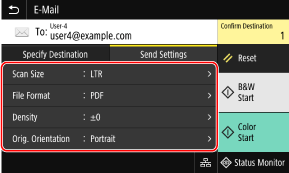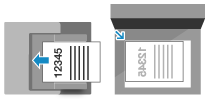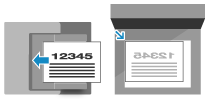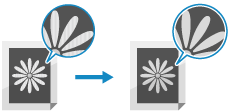
Scan Settings
When scanning with the machine, you can use the [Send Settings] tab on the scanning screen to set the original size and adjust the image quality.

If the scanned data does not appear as expected, you can change the settings and scan again.
* To start scanning, select the scanning color (black and white or color) by pressing [Start B&W] or [Start Color].
* To save scanned data to a computer, configure the settings with MF Scan Utility or ScanGear MF installed on the computer. You cannot use the control panel to configure the settings.
* To start scanning, select the scanning color (black and white or color) by pressing [Start B&W] or [Start Color].
* To save scanned data to a computer, configure the settings with MF Scan Utility or ScanGear MF installed on the computer. You cannot use the control panel to configure the settings.
 |
Registering Favorite SettingsYou can register frequently used scan settings as Favorite Settings to easily call up these settings as needed when scanning. Registering and Calling Up Favorite Settings You can also change the default scan settings. Changing the Default Settings Recalling Past Settings - TX Job LogYou can use the TX Job Log to recall the scan settings used to send or save scanned data in the past. Specifying Destinations (TX Job Log) * TX Job Log is not available when saving scanned data to a USB memory device. |
Setting the Original Size and Orientation
Set the size and orientation according to the original to be scanned.
[Scan Size]
Select the size of the placed original.
Select the size of the placed original.
Configuring Custom Sizes
Select [Specify Custom Size], enter the dimensions in [X] and [Y], and press [Apply].
When frequently used non-standard sizes are registered, you can call these up by pressing [S1] to [S3].
When frequently used non-standard sizes are registered, you can call these up by pressing [S1] to [S3].
Registering a Non-standard Size
Use the following procedure to register sizes when frequently using specific non-standard size originals. You can call up the size on the size input screen, saving you the trouble of entering the size each time.
You can register up to three non-standard sizes.
You can register up to three non-standard sizes.
[Specify Custom Size]  [Register Size] [Register Size]  select [S1] to [S3] select [S1] to [S3]  enter the dimensions in [X] and [Y] enter the dimensions in [X] and [Y]  [Apply] [Apply] |
On the size input screen, press [Name] to change the display name of [S1] to [S3].
Automatically Detecting the Size of the Original
When you select [Auto (LTR/LGL)], LTR, LGL, and STMT size paper is detected automatically.
When you place the original on the platen glass and press [Start B&W] or [Start Color], the [Scan Size] screen is displayed. Select the size of the original.
[Orig. Orientation]
Select [Portrait] or [Landscape] to suit the placed original.
Select [Portrait] or [Landscape] to suit the placed original.
[Portrait] | [Landscape] | |
 |  |
Adjusting Image Quality
You can adjust the image quality such as when the scanned data image is not clear or the text is difficult to read.
[Density]
Adjust the density to suit the original.
Press [+] to increase the density and [-] to lower it.
Adjust the density to suit the original.
Press [+] to increase the density and [-] to lower it.
[Original Type]
Select the original type.
Scanning is performed using the image quality to suit the content of the original.
Select the original type.
Scanning is performed using the image quality to suit the content of the original.
[Sharpness] Adjust the sharpness. Emphasize the contours and lines to make them clearer, or weaken them to make them softer. |
Adjustment example: To make blurry text or shapes clearer Press [+].  |
To reduce moiré (vertical pattern noise) in pictures Press [-].  |
 |
When the File Format of the Scanned Data Is JPEGThe image quality varies depending on the compression ratio selected in [Data Size]. Setting File / Division |
2-Sided Scan Settings
When scanning a 2-sided original, place the original on the feeder, and set [2-Sided Original].
[2-Sided Original]
When scanning a 2-sided original, select [Book Type] or [Calendar Type]. Select this according to the top and bottom orientation of the front and back sides of the placed original.
When scanning a 2-sided original, select [Book Type] or [Calendar Type]. Select this according to the top and bottom orientation of the front and back sides of the placed original.
[Book Type] | [Calendar Type] | |
 |  | |
Top and bottom have same orientation | Top and bottom have opposite orientation |
To cancel scanning of a 2-sided original, select [Off].
Setting Preview
To preview the scanned data before sending or saving it, enable [Preview].
* This setting is not available when saving the scanned data to a USB memory device.
* This setting is not available when saving the scanned data to a USB memory device.
[Preview]
To preview the scanned data before sending or saving it, select [On].
You can preview the scanned data on the control panel after scanning is completed. You can delete pages you do not want to send or save.
To preview the scanned data before sending or saving it, select [On].
You can preview the scanned data on the control panel after scanning is completed. You can delete pages you do not want to send or save.
Skipping Blank Pages
Enable [Skip Blank Orig.] to skip blank pages of an original automatically.
* This setting is not available when sending scanned data by I-Fax.
* This setting is not available when sending scanned data by I-Fax.
[Skip Blank Orig.]
To automatically delete pages that have been determined to be blank when scanning, select [On].
When both [On (Preview)] and [On (No Preview)] are displayed, select whether to check the preview image of the scanned data before sending or saving the data.
* When [Skip Blank Orig.] is set to [On], scanning is canceled when all pages of the scanned original are determined to be blank.
To automatically delete pages that have been determined to be blank when scanning, select [On].
When both [On (Preview)] and [On (No Preview)] are displayed, select whether to check the preview image of the scanned data before sending or saving the data.
* When [Skip Blank Orig.] is set to [On], scanning is canceled when all pages of the scanned original are determined to be blank.
[Adjust Recog Level]
Adjust the accuracy for detecting blank pages.
Selecting [+] increases the sensitivity level for detecting blank pages.
Adjust the accuracy for detecting blank pages.
Selecting [+] increases the sensitivity level for detecting blank pages.
Setting File / Division
Set the scanned data format and file name.
You can compress data and enable recognition of text in an original. You can also combine multiple originals into one file or create separate files for each original.
* The scanned data format setting is not available when sending scanned data by I-Fax. The scanned data is sent in TIFF format.
You can compress data and enable recognition of text in an original. You can also combine multiple originals into one file or create separate files for each original.
* The scanned data format setting is not available when sending scanned data by I-Fax. The scanned data is sent in TIFF format.
 |
To add encryption or a digital signature to a PDF file, you must use the optional Send PDF Security Feature Set. System Options |
[File Format]
Select the scanned data format from PDF, JPEG, or TIFF according to your purpose and environment.
Select the scanned data format from PDF, JPEG, or TIFF according to your purpose and environment.
Reducing the Data Size
When using PDF format
Select [PDF (Compact)] or [PDF (Compact/OCR)].
The data size is reduced, but the image quality and the number of sheets that can be scanned at a time may also be reduced depending on the original type.
Select [PDF (Compact)] or [PDF (Compact/OCR)].
The data size is reduced, but the image quality and the number of sheets that can be scanned at a time may also be reduced depending on the original type.
When using JPEG format
Select [JPEG], and set [Data Size] to [Small: Memory Priority].
Select [JPEG], and set [Data Size] to [Small: Memory Priority].
Enabling Recognition of Text in an Original
Select [PDF (OCR)] or [PDF (Compact/OCR)].
By default, [Orig. Orientation] is detected automatically according to the orientation of text detected when the PDF is created. [OCR (Text Searchable) Settings]
By default, [Orig. Orientation] is detected automatically according to the orientation of text detected when the PDF is created. [OCR (Text Searchable) Settings]
Combining Multiple Originals into One File
Select PDF or TIFF format.
Dividing the Original into Separate Files
When using PDF format
Select [Set PDF Details] select PDF format
select PDF format  press [Divide into Pages]
press [Divide into Pages]  [On].
[On].
Select [Set PDF Details]
 select PDF format
select PDF format  press [Divide into Pages]
press [Divide into Pages]  [On].
[On].When using TIFF format
Press [Set TIFF Details] [Divide into Pages]
[Divide into Pages]  [On].
[On].
Press [Set TIFF Details]
 [Divide into Pages]
[Divide into Pages]  [On].
[On].When using JPEG format
Select [JPEG].
Select [JPEG].
Enhancing PDF File Security
You can enhance the security of a PDF file by setting a password to encrypt the file and adding a digital signature. You can encrypt and digitally sign the same file.
* To add a digital signature, you must generate a key and certificate for device signature. Preparing to Add a Digital Signature to a PDF File
* To add a digital signature, you must generate a key and certificate for device signature. Preparing to Add a Digital Signature to a PDF File
When Encrypting the File
Select [Set PDF Details] select PDF format
select PDF format  [Encryption]
[Encryption]  select encryption level
select encryption level  enter a password, press [Apply]
enter a password, press [Apply]  confirm the password, and press [Apply].
confirm the password, and press [Apply].
* If you set the encryption level to [Acrobat 9.0 or Equivalent/256-bit AES] instead of [Acrobat 10.0 or Equivalent/256-bit AES], you must configure separate settings. [256-bit AES Set. (Encrypt. PDF)]
Select [Set PDF Details]
 select PDF format
select PDF format  [Encryption]
[Encryption]  select encryption level
select encryption level  enter a password, press [Apply]
enter a password, press [Apply]  confirm the password, and press [Apply].
confirm the password, and press [Apply]. * If you set the encryption level to [Acrobat 9.0 or Equivalent/256-bit AES] instead of [Acrobat 10.0 or Equivalent/256-bit AES], you must configure separate settings. [256-bit AES Set. (Encrypt. PDF)]
When Adding a Digital Signature
Select [Set PDF Details] select PDF format
select PDF format  press [Digital Signatures]
press [Digital Signatures]  [Top Left].
[Top Left].
Select [Set PDF Details]
 select PDF format
select PDF format  press [Digital Signatures]
press [Digital Signatures]  [Top Left].
[Top Left].[Data Size]
Select the data size when using JPEG format for the scanned data. The compression ratio varies according to the selected data size.
Select the data size when using JPEG format for the scanned data. The compression ratio varies according to the selected data size.
[Small: Memory Priority]
Increases the compression ratio but lowers the image quality.
Increases the compression ratio but lowers the image quality.
[Large: Image Quality Priority]
Lowers the compression ratio but increases the data size.
Lowers the compression ratio but increases the data size.
[File Name]
Specify a string to add to the start of the file name of the scanned data.
Specify a string to add to the start of the file name of the scanned data.
E-mail and I-Fax Settings
You can configure the e-mail settings when sending scanned data by e-mail or I-Fax.
[Subject/Message]
Set the subject and main body of the e-mail.
Set the subject and main body of the e-mail.
[Reply To]
Select an e-mail address (Reply-To) from the Address Book to be used for e-mail recipients to reply to.
If no e-mail address is selected here, the e-mail address of the machine is used as the Reply-To e-mail address.
* If the e-mail address you want to use is not registered in the Address Book, register it, and then select it. Address Book Function
Select an e-mail address (Reply-To) from the Address Book to be used for e-mail recipients to reply to.
If no e-mail address is selected here, the e-mail address of the machine is used as the Reply-To e-mail address.
* If the e-mail address you want to use is not registered in the Address Book, register it, and then select it. Address Book Function
[Priority]
Select the priority level.
Select the priority level.
 | |
E-mail SenderThe e-mail address of the machine becomes the sender e-mail address (From) regardless of the [Reply To] setting. To send the sender's name along with the e-mail address of the machine, use the following procedure to set the unit name.
On the control panel, select [Menu] in the [Home] screen, and then select [Function Settings] to configure the settings. [Register Unit Name] The e-mail sender is the setting shared with the machine. |